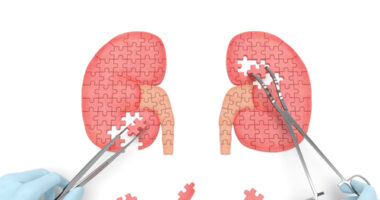Ongoing Research Testing Several New Therapies for Alport Syndrome

While Alport syndrome currently remains without a cure, ongoing research is testing several strategies that hold promise, a review study shows.
The review, “New therapeutic options for Alport syndrome,” was published in the journal Nephrology Dialysis Transplantation.
Alport syndrome is an inherited disease caused by mutations in the three genes — COL4A3, COL4A4, and COL4A5 — that contain the instructions for making type IV collagen protein. Collagen IV is a connective protein essential in the filtering role of kidneys. It is a key component of the glomerular basement membrane (GBM), a cell layer essential for filtering out waste products at the kidney glomeruli.
While disease severity varies according to the inherited mutation, the mutated collagen IV protein makes the GBM more vulnerable to the pressure inside its small blood vessels, leading to damages.
The decline of the glomerular filtration rate — a key feature of kidney function — is a primary endpoint of disease progression in many AS clinical trials.
“But similarly to other renal diseases, this is probably too late an endpoint to make a significant impact on the course of the disease,” the study’s main author, Roser Torra, MD, PhD, professor at the nephrology department of Fundació Puigvert, Barcelona, said in a press release.
“Theoretically, treatment prior to the appearance of renal [scarring] offers more promising long-term renal outcomes. GBM aspect and degree of fibrosis on renal biopsy as well as [presence of excess proteins in the urine, a sign of kidney malfunction] could be excellent endpoints for clinical trials,” she added.
Measuring GBM damage is the most reliable marker for Alport syndrome progression. Damage to GBM makes kidney cells, called podocytes, secrete signaling molecules (chemokines and cytokines) that promote fibrosis and tubular atrophy, or shrinkage, in the kidney. Animal models of Alport syndrome also suggest that there is a local production of angiotensinogen, which further contributes to GBM damaging.
Currently, inhibitors of the renin-angiotensin-aldosterone system (RAAS), used in the treatment of high blood pressure, are widely used to treat diseases such as Alport syndrome, although they are not technically approved by regulatory agencies.
RAAS blockers have been shown to delay progression of chronic kidney disease, and evidence suggests that inhibitors of the angiotensin enzyme delay the need for dialysis and improve survival in all forms of Alport syndrome.
A Phase 3 clinical trial (NCT01485978), currently ongoing in Germany, is testing the safety and efficacy of ramipril (sold under the brand name Altace, among others), an angiotensin-converting enzyme inhibitor, in children with Alport syndrome.
In line with the RAAS blockers’ action, research suggests that paricalcitol, an activator of the vitamin D pathway, together with angiotensin enzyme inhibitors could delay renal failure. However, evidence on this treatment is not sufficient to recommend its use in patients.
Increasing evidence suggests that other therapies may have a therapeutic benefit for Alport syndrome.
Bardoxolone, which halts inflammation and oxidative damage, increases the glomerular filtration rate. The Phase 2/3 CARDINAL trial (NCT03019185) is evaluating the therapy’s tolerability and efficacy in children and adults with Alport syndrome.
Medicines used to lower fat (lipids) — the so-called statins — may also benefit Alport syndrome patients, as research suggests that high levels of fat may promote damage to the GBM.
A study in a mouse model of Alport syndrome showed that treatment with a statin protected mice against the development of progressive renal failure and fibrosis, and improved survival. However, its use could have severe side effects for Alport syndrome patients.
Cells have mechanisms to destroy abnormal proteins, such as the mutated type IV collagen. However, a class of proteins called chaperones help other proteins achieve a correct 3D structure and could help improve the “folding” of the mutated type IV collagen that, even not performing as the normal protein, could help enhance the GBM performance in Alport syndrome.
Beyond these therapies, further advanced strategies also hold promise. This includes the use of anti-microRNAs. Unlike other RNA molecules, microRNAs do not give rise to a protein, but regulate gene expression (protein production).
The levels of a particular microRNA, called microRNA-21, are present at high levels in the kidneys of people with Alport syndrome. Experiments in a mouse model of Alport syndrome showed that an anti-microRNA 21 therapy halted disease progression and enhanced the animals’ survival by more than 40 percent.
A stem cell-based therapy can also help researchers create functional podocytes that produce healthy collagen and could restore the GBM upon transplantation into a diseased kidney. Research done in mice showed that the transplanted cells slowed kidney disease progression and extended the animal’s survival.
Overall, “the ideal drug for [Alport syndrome] should replace the abnormal GBM and could be administered for many years in young adults and children. It should also be administered orally, be cheap, exert a known and measurable biological effect, and possess an excellent safety profile,” researchers said.
Torra said that although “a specific disease-modifying therapy for [Alport syndrome] remains an unmet need, I am sure this will change, because AS has become a very attractive disease for pharmaceutical companies to target.”







Leave a comment
Fill in the required fields to post. Your email address will not be published.